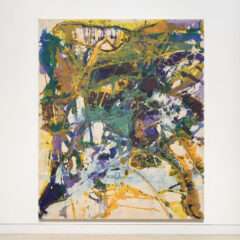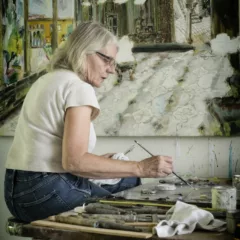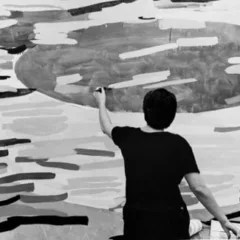Two solo exhibitions take over Locks Gallery now through Oct. 8. Neysa Grassi ‘s Rose Gatherer on the third floor showcases the last ten years of paintings by the Philadelphia artist. The abstract paintings reveal the artist’s attention to mark-making and to the physicality of her process. Rob Wynne’s IN COG NITO on the first floor shows the New York artist’s fascination with the relationship between art and language. From his first explorations in the 1970s to his most recent work, IN COG NITO provides a survey of Wynne’s interest in text-based art.
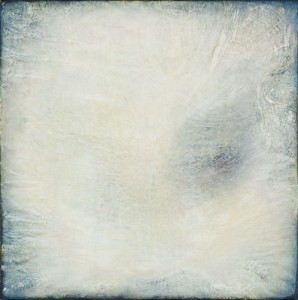
Grassi’s laborious process lends each of her works a presence. Viewing the oil paintings is not a passive activity, but a process of constantly moving closer and farther away. The artist’s palette of soft reds, blues, and yellows blends together to form a misty haze of color when viewed from a distance. By moving closer, the artist’s hand in creating each piece becomes apparent. Grassi’s process involves building up successive layers of paint and sanding down certain portions. The result is a meticulously detailed surface that feels weathered and aged. Her paintings cannot be taken in with a quick glance. Instead, time is needed to realize their complexity.
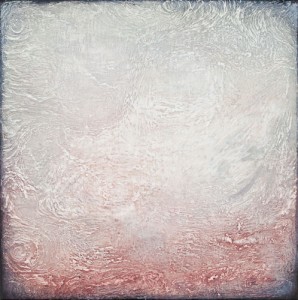
The paintings in Rose Gatherer recall seascapes, gardens, and other natural settings. However, these natural scenes are suggested instead of being depicted clearly. By only alluding to a place, Grassi’s images engage viewers on a sensory level bringing to mind their own experiences in nature. This idea of the sensual is also reflected in the artist’s layered mark-making, which takes on the appearance of human flesh. With its scarred and weathered appearance, Grassi’s work suggests human fragility in the face of natural forces.
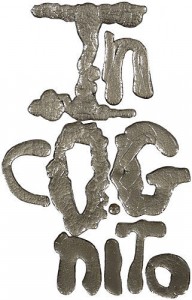
The shimmering pieces of poured and mirrored glass that wrap around three walls of Rob Wynne’s IN COG NITO reveal the artist’s affinity for words, and the complexity in the seemingly straightforward. Each word — mounted on the walls without hardware showing — has been written in a way to reflect its meaning. For example, the letters in the word incognito have been written as “IN COG NITO,” the 3 separate parts written below each other — to disguise its identity. The self-reflexive quality of each word is played up by the artist’s choice of mirrored glass as a material.
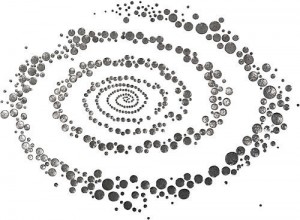
“Vortex,” 2011 is one of the few pieces that does not spell out a word. Instead, it is composed of small drips that have been arranged in a spiral formation on the wall. Like its cosmic form, the spiral is symbolic of the universal and reflects a desire for language to behave like an iconic image and be understood by all. The pattern and the artist’s use of shimmering, silver material suggest an otherworldliness and the engulfing confusion that language can cause.
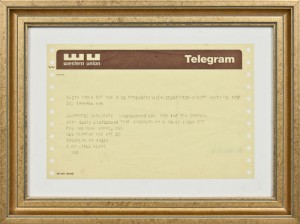
The remaining wall of the gallery contains the artist’s framed works which date back to the 1970s. “I am still alive,” 1972 is a telegram sent by the artist declaring he is still living. However, there is no guarantee the statement is still true by the time the message is received.

“STOP THINKING,” 2008 (a photo bearing the words) displays its gray text on a gray background with only slight contrast between the two shades. The difficulty of reading the words produces a strained facial expression that resembles deep thought, and the directive to stop thinking ironically triggers thought. In “Can You Explain,” 2000, the question, “Can you explain what you mean by that?,” is sewn into a piece of vellum. The letters are written in a precise manner that suggests clarity, but the vellum allows the threads from behind to show through, suggesting an inner confusion.
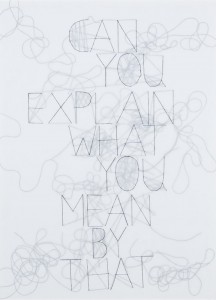
The work presented at Locks Gallery is the result of sustained areas of focus by both artists. Each seems to be asking fundamental questions about his/her medium of choice. For Neysa Grassi in Rose Gatherer, her interest in process reflects painterly concerns about the potential of the abstract and the representational. For Rob Wynne, his interest in the visual and the written reflects an interest in communication, and like the title of the show IN COG NITO, its potential to be less than straightforward.


